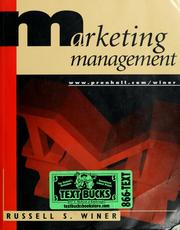| Listing 1 - 10 of 102 | << page >> |
Sort by
|
Article
Abstract | Keywords | Export | Availability | Bookmark
 Loading...
Loading...Choose an application
- Reference Manager
- EndNote
- RefWorks (Direct export to RefWorks)
Book
ISBN: 0131228013 Year: 2004 Publisher: Upper Saddle River Prentice Hall
Abstract | Keywords | Export | Availability | Bookmark
 Loading...
Loading...Choose an application
- Reference Manager
- EndNote
- RefWorks (Direct export to RefWorks)
Marketing --- 658.8 --- Marketing. Sales. Selling. Distribution --- 658.8 Marketing. Sales. Selling. Distribution --- Management.

ISBN: 0709924992 9780709924999 Year: 1986 Publisher: London Croom Helm
Abstract | Keywords | Export | Availability | Bookmark
 Loading...
Loading...Choose an application
- Reference Manager
- EndNote
- RefWorks (Direct export to RefWorks)
Grammar --- Grammar, Comparative and general --- Grammaire comparée --- Word order --- Ordre des mots --- -801.56 --- Comparative grammar --- Grammar, Philosophical --- Grammar, Universal --- Language and languages --- Philosophical grammar --- Linguistics --- Philology --- Syntaxis. Semantiek --- Grammar, Comparative --- Word order. --- 801.56 Syntaxis. Semantiek --- Grammaire comparée --- 801.56 --- Order (Grammar) --- Grammar, Comparative and general - Word order

ISBN: 0321014219 9780321014214 Year: 2000 Publisher: Upper Saddle River : Prentice Hall,
Abstract | Keywords | Export | Availability | Bookmark
 Loading...
Loading...Choose an application
- Reference Manager
- EndNote
- RefWorks (Direct export to RefWorks)
Marketing --- Management. --- Management --- Marketing - Management

ISBN: 9027228817 0915027860 9027228825 0915027852 9786613092939 9027286272 128309293X 9789027286277 9780915027859 9780915027866 9789027228819 9789027228826 6613092932 9781283092937 Year: 1987 Volume: 11 Publisher: Amsterdam Philadelphia J. Benjamins Pub. Co.
Abstract | Keywords | Export | Availability | Bookmark
 Loading...
Loading...Choose an application
- Reference Manager
- EndNote
- RefWorks (Direct export to RefWorks)
This volume seeks to expand our understanding of the relation holding between discourse relations, cognitive units, and linguistic coding. The twenty contributions in this collection explore one or more of the following themes: How point of view, or the salience of information in discourse, affects the organizational coherence of text and discourse; the concept of cognitive and linguistic event and how events are reflected in text and discourse organization; the nature of linguistic coding of events and other kinds of significant information; and the cognitive bases or cognitive correla
801.56 --- Syntaxis. Semantiek --- 801.56 Syntaxis. Semantiek --- Cohesion (Linguistics) -- Congresses. --- Discourse analysis -- Congresses. --- Grammar, Comparative and general -- Syntax -- Congresses. --- Psycholinguistics -- Congresses. --- Cohesion (Linguistics) --- Coherence (Linguistics) --- Cohesiveness (Linguistics) --- Discourse analysis --- Grammar, Comparative and general --- Psycholinguistics --- Linguistics --- Syntax --- Pragmatics --- Congresses --- Grammar [Comparative and general ] --- Philology
Book
ISBN: 9781978802865 9781978802872 9781978802889 9781978802896 9781978802902 Year: 2019 Publisher: New Brunswick, NJ
Abstract | Keywords | Export | Availability | Bookmark
 Loading...
Loading...Choose an application
- Reference Manager
- EndNote
- RefWorks (Direct export to RefWorks)
In the aftermath of the genocide, the Rwandan government has attempted to use the education system in order to sustain peace and shape a new generation of Rwandans. Their hope is to create a generation focused on a unified and patriotic future rather than the ethnically divisive past. Yet, the government’s efforts to manipulate global models around citizenship, human rights, and reconciliation to serve its national goals have had mixed results, with new tensions emerging across social groups. Becoming Rwandan argues that although the Rwandan government utilizes global discourses in national policy documents, the way in which teachers and students engage with these global models distorts the intention of the government, resulting in unintended consequences and undermining a sustainable peace
Education and state --- Education --- Citizenship --- Transitional justice --- Peace-building --- Reconciliation --- Genocide --- Social aspects --- History --- Rwanda --- Atrocities. --- Political sociology --- Sociology of education
Book
ISBN: 1978802900 1978802870 1978802862 1978802889 9781978802902 9781978802865 9781978802872 Year: 2019 Publisher: New Brunswick Rutgers University Press
Abstract | Keywords | Export | Availability | Bookmark
 Loading...
Loading...Choose an application
- Reference Manager
- EndNote
- RefWorks (Direct export to RefWorks)
In the aftermath of the genocide, the Rwandan government has attempted to use the education system in order to sustain peace and shape a new generation of Rwandans. Their hope is to create a generation focused on a unified and patriotic future rather than the ethnically divisive past. Yet, the government’s efforts to manipulate global models around citizenship, human rights, and reconciliation to serve its national goals have had mixed results, with new tensions emerging across social groups. Becoming Rwandan argues that although the Rwandan government utilizes global discourses in national policy documents, the way in which teachers and students engage with these global models distorts the intention of the government, resulting in unintended consequences and undermining a sustainable peace.
Education and state --- Education --- Citizenship --- Transitional justice --- Peace-building --- Reconciliation --- Genocide --- Peace making --- Peacemaking --- Reconciliatory behavior --- Quarreling --- Building peace --- Peacebuilding --- Conflict management --- Peace --- Peacekeeping forces --- Justice --- Human rights --- Birthright citizenship --- Citizenship (International law) --- National citizenship --- Nationality (Citizenship) --- Political science --- Public law --- Allegiance --- Civics --- Domicile --- Political rights --- Children --- Education, Primitive --- Education of children --- Human resource development --- Instruction --- Pedagogy --- Schooling --- Students --- Youth --- Civilization --- Learning and scholarship --- Mental discipline --- Schools --- Teaching --- Training --- Education policy --- Educational policy --- State and education --- Social policy --- Endowment of research --- Social aspects --- History --- Law and legislation --- Government policy --- Rwanda --- Atrocities. --- Rwanda, Rwandan, genocide, political violence, human rights, education, post-genocide, government, Rwandan government, peace, unification, patriotism, citizenship, reconciliation, teachers, students, global models, school, peacebuilding, state-building, limitations of education, intergroup conflict, Rwandan genocide.
Book
ISBN: 0128189126 0128189134 9780128189139 9780128189122 Year: 2022 Publisher: Cambridge, MA
Abstract | Keywords | Export | Availability | Bookmark
 Loading...
Loading...Choose an application
- Reference Manager
- EndNote
- RefWorks (Direct export to RefWorks)
Handbook of Nonwovens, Second Edition updates and expands its popular interdisciplinary treatment of the properties, processing, and applications of nonwovens. Initial chapters review the development of the industry and the different classes of nonwoven material. The book then discusses methods of manufacture such as dry-laid, wet-laid, and polymer-laid web formation. Other techniques analyzed include mechanical, thermal, and chemical bonding, as well as chemical and mechanical finishing systems. The book concludes by assessing the characterization, testing, and modeling of nonwoven materials. Covering an unmatched range of materials with a variety of compositions and manufacturing routes, this remains the indispensable reference to nonwovens for designers, engineers, materials scientists, and researchers, particularly those interested in the manufacturing of automotive, aerospace, and medical products. Nonwovens are a unique class of textile material formed from fibers that are bonded together through various means to form a coherent structure. The range of properties they can embody make them an important part of a range of innovative products and solutions, which continues to attract interest from industry as well as academia.
Nonwoven fabrics --- Fabrics, Nonwoven --- Synthetic fabrics --- Textile fabrics --- Nonwoven fabrics. --- Nonwoven fabrics industry. --- Textile industry --- Synthetic fibers industry
Book
ISBN: 9780900572760 0900572760 Year: 1993 Publisher: Nottingham: University of Nottingham,
Abstract | Keywords | Export | Availability | Bookmark
 Loading...
Loading...Choose an application
- Reference Manager
- EndNote
- RefWorks (Direct export to RefWorks)

ISBN: 047180827X Year: 1987 Publisher: New York (N.Y.) : Wiley,
Abstract | Keywords | Export | Availability | Bookmark
 Loading...
Loading...Choose an application
- Reference Manager
- EndNote
- RefWorks (Direct export to RefWorks)
| Listing 1 - 10 of 102 | << page >> |
Sort by
|

 Search
Search Feedback
Feedback About UniCat
About UniCat  Help
Help News
News